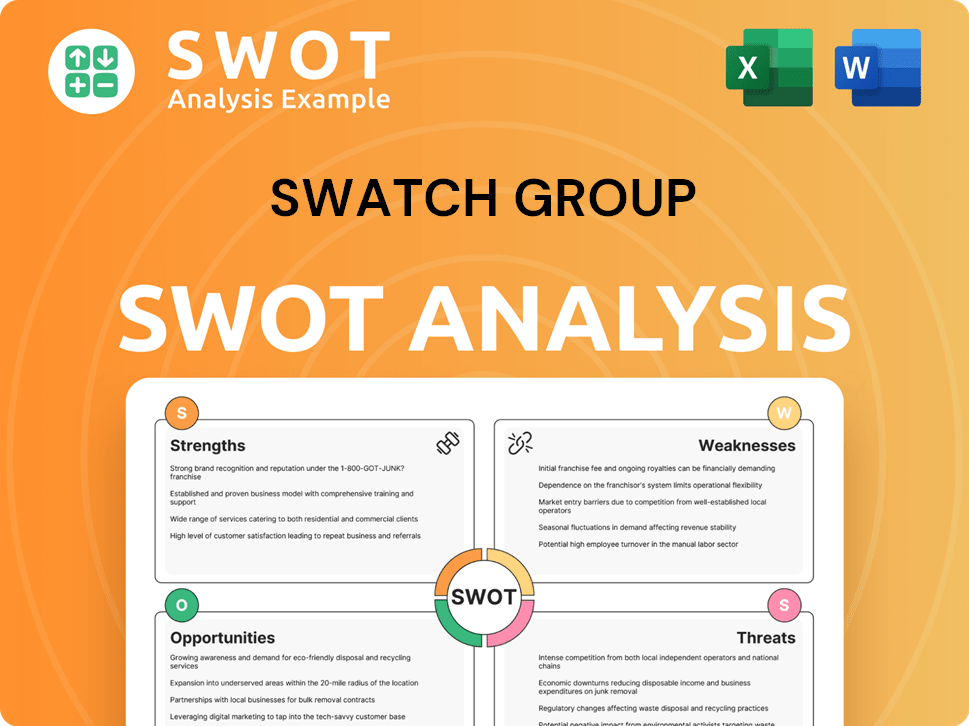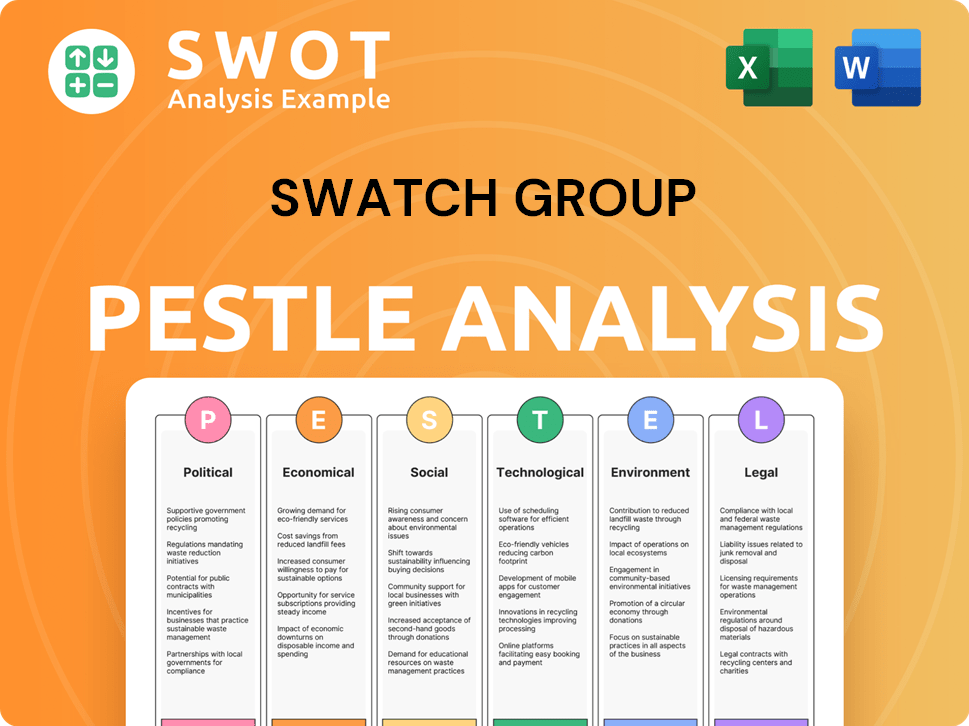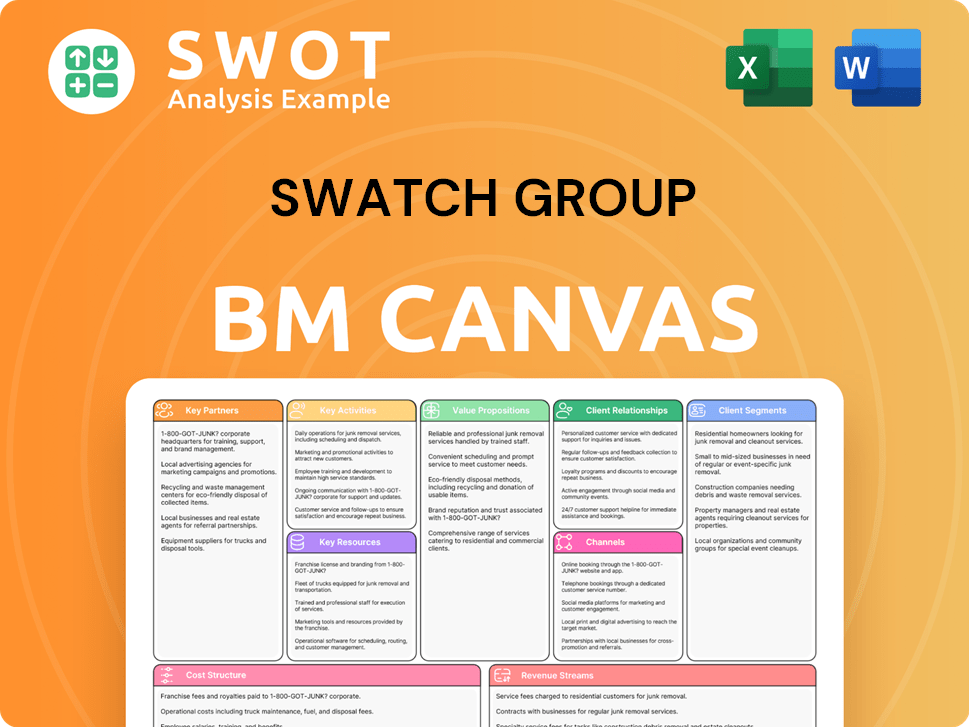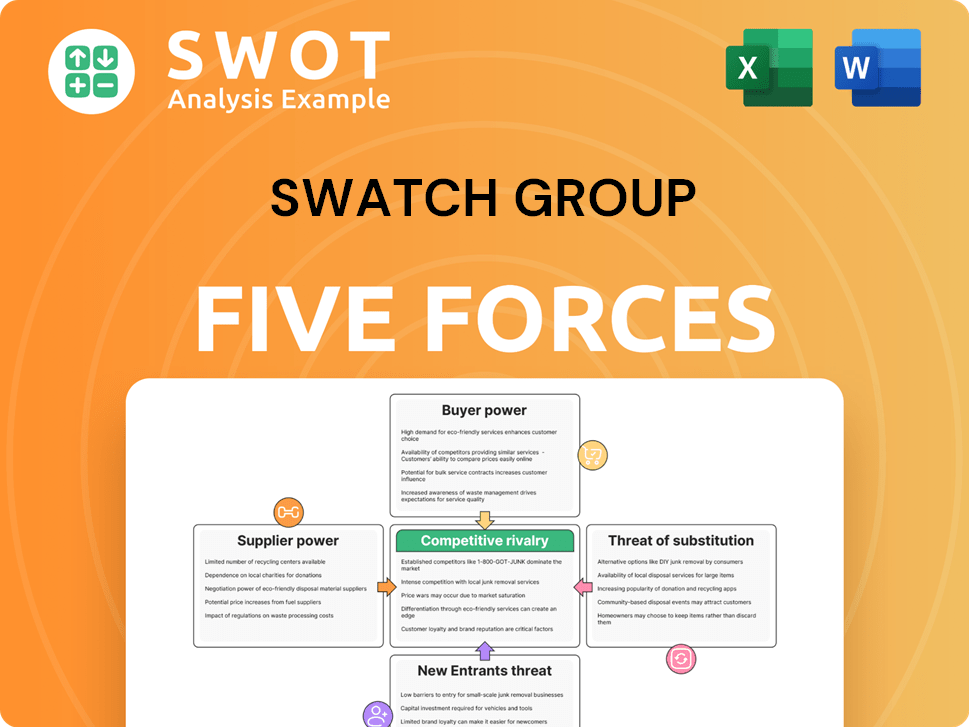Swatch Group Bundle
How did Swatch Watches Save Swiss Watchmaking?
In the early 1980s, the Swiss watch industry teetered on the brink of collapse, threatened by affordable quartz watches. From this crisis emerged a revolutionary idea: the Swatch watch, a concept that would not only revive the industry but also birth a global powerhouse. This innovation led to the creation of The Swatch Group, a company that would redefine the landscape of Swatch Group SWOT Analysis.

The Swatch Group's story is a compelling narrative of strategic innovation and resilience, transforming a near-death experience into a position of global dominance. The company's success is a testament to its ability to adapt and innovate, as it now controls a diverse portfolio of watch brands ranging from entry-level to luxury. This brief history of Swatch Group will explore the company's beginnings, its key milestones, and its impact on the world of Swiss watchmaking and luxury watches.
What is the Swatch Group Founding Story?
The Swatch Group's story begins in the face of a major crisis. The Swiss watchmaking industry was struggling in the 1970s and early 1980s. Cheaper quartz watches from Japan were taking over the market. This led to the creation of the 'Swatch' watch, a brand that would change the industry.
To combat this, the two biggest Swiss watch groups, ASUAG and SSIH, merged. This happened under the leadership of Nicolas G. Hayek. This merger, which happened in 1983, formed SMH (Société Suisse de Microélectronique et d'Horlogerie). The company was later renamed The Swatch Group in 1998. Hayek's strategy was key to saving Swiss watchmaking. He saw that the problem wasn't quality, but the need to compete on price and reach more customers.
The goal was to create a high-quality, Swiss-made quartz watch that was affordable and fashionable. This led to the launch of the 'Swatch' watch in 1983. These watches had plastic cases, fewer parts, and innovative manufacturing. This helped to lower production costs. Swiss banks provided the initial funding. Hayek's vision was to move from luxury to mass appeal, combining Swiss precision with accessible design. This strategic shift was vital for the industry's revival and set the stage for The Swatch Group's future success.
The Swatch Group's innovative approach included mass production and a focus on design.
- The 'Swatch' watch was designed with fewer components, making it cheaper to produce.
- The company targeted a broader market by offering fashionable and affordable watches.
- The strategic shift from luxury to mass appeal was crucial for survival.
- The initial funding from Swiss banks demonstrated confidence in the new strategy.
The Marketing Strategy of Swatch Group played a key role in its success. The company focused on innovative marketing and branding. This helped to establish the brand's identity and appeal to a wide audience.
Swatch Group SWOT Analysis
- Complete SWOT Breakdown
- Fully Customizable
- Editable in Excel & Word
- Professional Formatting
- Investor-Ready Format

What Drove the Early Growth of Swatch Group?
Following the 1983 launch of the Swatch watch, the newly formed SMH experienced rapid growth and expansion. The initial market response was overwhelmingly positive, particularly in Europe and North America, where the colorful, affordable, and fashionable watches quickly became a cultural phenomenon. Early product launches included various color collections and special editions, leveraging the watch's appeal as a fashion accessory. The company quickly scaled its production to meet demand, establishing efficient manufacturing processes.
The initial market reception of Swatch watches was exceptionally positive, especially in Europe and North America. The watches' appeal as fashion accessories drove early product launches, including diverse color collections and special editions. This strategy helped establish the brand's presence in the market and meet consumer demand.
SMH expanded its portfolio beyond the core Swatch brand through acquisitions and mergers. Brands like Breguet, Blancpain, and Glashütte Original were added, alongside existing brands such as Omega, Longines, Tissot, and Rado. This multi-brand strategy allowed the company to cater to different market segments, from entry-level to high-end luxury.
SMH established a strong global distribution network and became a diversified conglomerate. Vertical integration was a strategic advantage, ensuring control over the supply chain and fostering innovation. This expansion was characterized by aggressive marketing, product diversification, and strategic acquisitions.
The company's sustained growth is evident in its financial performance. The revenue in 2023 was CHF 7,888 million (approximately USD 8.7 billion), demonstrating its strong position in the global watch industry. For more insights into the competitive landscape, consider reading about the Competitors Landscape of Swatch Group.
Swatch Group PESTLE Analysis
- Covers All 6 PESTLE Categories
- No Research Needed – Save Hours of Work
- Built by Experts, Trusted by Consultants
- Instant Download, Ready to Use
- 100% Editable, Fully Customizable

What are the key Milestones in Swatch Group history?
The Swatch Group has a rich history, marked by significant milestones that have shaped the Swiss watchmaking industry. From its inception during the quartz crisis to its present-day status as a global leader, the group's journey is a testament to its resilience and strategic foresight. The evolution of Swatch watches, and its subsequent expansion into various segments of the luxury watches market, showcases the group's adaptability and innovative spirit.
| Year | Milestone |
|---|---|
| 1983 | Launch of the Swatch watch, revolutionizing the watch industry with its accessible price and fashionable designs. |
| 1990 | Introduction of Swatch Scuba and Swatch Chrono, expanding the product range and market reach. |
| 1991 | Development of the automatic Swatch, showcasing technical innovation in an accessible format. |
| 2013 | Introduction of the 'Sistem51' movement, an automatic mechanical movement with only 51 components, demonstrating engineering prowess. |
| Ongoing | Continuous expansion of the brand portfolio through acquisitions and organic growth, solidifying its position in the luxury watches market. |
Innovations have been a cornerstone of the Swatch Group's success, driving its evolution within the Swiss watchmaking sector. These innovations have not only enhanced its product offerings but also redefined the standards of the watch industry, making luxury watches more accessible and desirable.
The Swatch watch itself was a groundbreaking innovation, offering a fashionable and affordable alternative to traditional Swiss watches. This move democratized the market, attracting a new generation of consumers to the world of watch brands.
The introduction of Swatch Scuba and Chrono models expanded the brand's appeal by catering to different consumer preferences. These models demonstrated Swatch's ability to innovate beyond its core product, adapting to market demands.
The Sistem51 movement was a major technological achievement, showcasing the group's commitment to accessible mechanical watchmaking. This innovation proved that complex mechanics could be simplified and produced efficiently.
The development of connected watches, such as the Tissot T-Touch Connect Solar, demonstrates the group's adaptation to the digital age. This move ensures the brand remains relevant in a market increasingly dominated by smart technology.
The Swatch Group has consistently innovated in materials science, using new materials to create durable and aesthetically pleasing watches. This includes the use of plastic, silicone, and other innovative materials.
The group has also invested in advanced manufacturing processes, enabling the efficient production of high-quality watches. This includes automation and the use of robotics to improve precision and reduce costs.
The Swatch Group has faced several challenges throughout its history, particularly within the Swiss watchmaking industry. These challenges have tested its resilience, requiring strategic adaptations to maintain its market position.
The quartz crisis of the 1970s and 1980s posed a significant threat to traditional Swiss watchmakers. The Swatch Group's formation was a direct response to this challenge, with the goal of revitalizing the industry.
The rise of smartwatches has presented a new competitive landscape. The Swatch Group has responded by integrating connected features into its watch brands, ensuring it remains competitive in the evolving market.
Global economic downturns and currency fluctuations have impacted the Swatch Group's financial performance. The group has strategically managed its brand portfolio to mitigate these effects, focusing on different price segments.
Supply chain disruptions, such as those experienced during the COVID-19 pandemic, have presented operational challenges. The Swatch Group has worked to diversify its supply chains and improve resilience.
Changing consumer preferences and trends have required the Swatch Group to adapt its marketing strategies and product offerings. This includes a greater emphasis on digital marketing and sustainable practices.
Maintaining a strong brand identity across its diverse portfolio of watch brands has been crucial. The group has focused on preserving the unique character of each brand while ensuring they align with overall strategic goals.
Swatch Group Business Model Canvas
- Complete 9-Block Business Model Canvas
- Effortlessly Communicate Your Business Strategy
- Investor-Ready BMC Format
- 100% Editable and Customizable
- Clear and Structured Layout

What is the Timeline of Key Events for Swatch Group?
The Swatch Group's journey began in 1983 with the formation of SMH, later renamed to The Swatch Group, marking a pivotal moment in Swatch history. The company launched the iconic Swatch watch, quickly followed by innovations like the Swatch Scuba and Chrono in the early 1990s. Key acquisitions, such as Breguet and Jaquet Droz, expanded its luxury portfolio, while the introduction of the Sistem51 in 2013 showcased its commitment to Swatch Group innovation. The company has navigated challenges, including a sales decline during the 2020 pandemic, followed by a strong rebound in 2021, demonstrating its resilience and adaptability in the Swiss watchmaking industry.
| Year | Key Event |
|---|---|
| 1983 | Formation of SMH (Société Suisse de Microélectronique et d'Horlogerie) and launch of the Swatch watch. |
| 1986 | Nicolas G. Hayek becomes CEO of SMH. |
| 1990 | Launch of the Swatch Scuba and Swatch Chrono. |
| 1991 | Launch of the automatic Swatch. |
| 1998 | SMH is renamed The Swatch Group. |
| 1999 | Acquisition of Breguet and Jaquet Droz. |
| 2003 | Nicolas G. Hayek Jr. becomes CEO of Swatch Group. |
| 2010 | Passing of Nicolas G. Hayek Sr. |
| 2013 | Introduction of the Sistem51, an automatic movement with 51 components. |
| 2015 | Launch of Swatch Bellamy, a payment-enabled watch. |
| 2020 | Significant decline in net sales due to the COVID-19 pandemic. |
| 2021 | Strong rebound in sales and profit following the pandemic. |
| 2023 | Net sales reached CHF 7,888 million (approximately USD 8.7 billion). |
The Swatch Group continues to invest heavily in research and development. This includes exploring new materials, sustainable practices, and innovative movements. The Sistem51 is a prime example of their commitment to pushing boundaries in Swiss watchmaking.
Strengthening its e-commerce presence and enhancing the digital customer experience are key priorities. This involves improving online platforms and utilizing digital marketing strategies. This will help the company to reach a wider audience.
The luxury segment, including brands like Omega and Breguet, remains a core focus. These brands achieved significant growth in 2023. The company plans to continue investing in these high-end brands.
The Swatch Group is well-positioned to capitalize on the increasing demand for sustainable products and the continued growth of the luxury watches market. Analyst predictions suggest continued growth in the luxury watch sector. The company is also exploring opportunities in the connected watch market.
Swatch Group Porter's Five Forces Analysis
- Covers All 5 Competitive Forces in Detail
- Structured for Consultants, Students, and Founders
- 100% Editable in Microsoft Word & Excel
- Instant Digital Download – Use Immediately
- Compatible with Mac & PC – Fully Unlocked

Related Blogs
- What is Competitive Landscape of Swatch Group Company?
- What is Growth Strategy and Future Prospects of Swatch Group Company?
- How Does Swatch Group Company Work?
- What is Sales and Marketing Strategy of Swatch Group Company?
- What is Brief History of Swatch Group Company?
- Who Owns Swatch Group Company?
- What is Customer Demographics and Target Market of Swatch Group Company?
Disclaimer
All information, articles, and product details provided on this website are for general informational and educational purposes only. We do not claim any ownership over, nor do we intend to infringe upon, any trademarks, copyrights, logos, brand names, or other intellectual property mentioned or depicted on this site. Such intellectual property remains the property of its respective owners, and any references here are made solely for identification or informational purposes, without implying any affiliation, endorsement, or partnership.
We make no representations or warranties, express or implied, regarding the accuracy, completeness, or suitability of any content or products presented. Nothing on this website should be construed as legal, tax, investment, financial, medical, or other professional advice. In addition, no part of this site—including articles or product references—constitutes a solicitation, recommendation, endorsement, advertisement, or offer to buy or sell any securities, franchises, or other financial instruments, particularly in jurisdictions where such activity would be unlawful.
All content is of a general nature and may not address the specific circumstances of any individual or entity. It is not a substitute for professional advice or services. Any actions you take based on the information provided here are strictly at your own risk. You accept full responsibility for any decisions or outcomes arising from your use of this website and agree to release us from any liability in connection with your use of, or reliance upon, the content or products found herein.